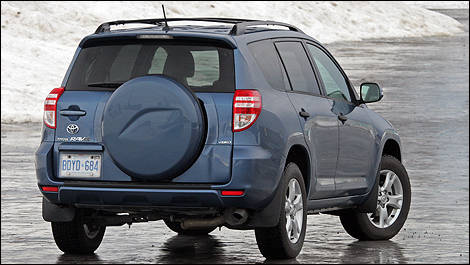The Toyota RAV4 is one of the most popular compact SUVs on the market right now. In fact, only the Ford Escape is a better seller in this segment. More importantly, since 2005, the little Toyota has been enjoying a steady rise in sales while its arch nemesis, the Honda CR-V (third on sales charts) has been experiencing a slight decline over the past year.
The sustained popularity of the RAV4 is certainly the result of its wide range of available models. Unlike the CR-V, which only comes as a 5-passenger, 4-cylinder SUV, the RAV4 offers 5- or 7-passenger seating as well as a fuel-efficient four-banger or a powerful V6.
Let’s go with the powerful V6
The latest generation of this compact ute, introduced for 2006, received some notable changes under the hood as part of its 2009 mid-cycle update. First, the 4-cylinder engine now displaces 2.5 litres (instead of 2.4) and produces 179 horsepower (instead of 166). That’s 13 horsepower more than a comparable CR-V.
This thrifty performer, which averages 8.5 litres per 100 kilometres according to the automaker, has won over many consumers since the beginning of the year. Insider sources claim that the demand for the smaller mill has increased by 40 percent, most likely due to the economic crisis.
One of the highlights of the Toyota RAV4 used to be its potent, Avalon-derived 3.5-litre V6. Mated to a 5-speed automatic transmission, it still generates an impressive 269 horsepower which, given the vehicle’s 1,600 kilos or so, makes for an equally impressive power-to-weight ratio.
When clocked, the RAV4 V6 reaches 100 km/h from a standstill in less than 8 seconds… with an autobox, mind you! Meanwhile, the 4-cylinder model (with 4-speed transmission) takes a little over 10 seconds to get to the same speed. No manual gearbox is available.
Is all that power justified in a family-oriented vehicle? I’m not so sure. Of course, some will use this argument to fuel conversations and impress their neighbors.
 |
| Toyota offers nine -- that's right, nine -- different models with the 2009 RAV4. |
The sustained popularity of the RAV4 is certainly the result of its wide range of available models. Unlike the CR-V, which only comes as a 5-passenger, 4-cylinder SUV, the RAV4 offers 5- or 7-passenger seating as well as a fuel-efficient four-banger or a powerful V6.
Let’s go with the powerful V6
The latest generation of this compact ute, introduced for 2006, received some notable changes under the hood as part of its 2009 mid-cycle update. First, the 4-cylinder engine now displaces 2.5 litres (instead of 2.4) and produces 179 horsepower (instead of 166). That’s 13 horsepower more than a comparable CR-V.
This thrifty performer, which averages 8.5 litres per 100 kilometres according to the automaker, has won over many consumers since the beginning of the year. Insider sources claim that the demand for the smaller mill has increased by 40 percent, most likely due to the economic crisis.
One of the highlights of the Toyota RAV4 used to be its potent, Avalon-derived 3.5-litre V6. Mated to a 5-speed automatic transmission, it still generates an impressive 269 horsepower which, given the vehicle’s 1,600 kilos or so, makes for an equally impressive power-to-weight ratio.
When clocked, the RAV4 V6 reaches 100 km/h from a standstill in less than 8 seconds… with an autobox, mind you! Meanwhile, the 4-cylinder model (with 4-speed transmission) takes a little over 10 seconds to get to the same speed. No manual gearbox is available.
Is all that power justified in a family-oriented vehicle? I’m not so sure. Of course, some will use this argument to fuel conversations and impress their neighbors.
 |
| Unlike its arch nemesis, the Honda CR-V, the Toyota RAV4 can be powered by a potent V6. |




